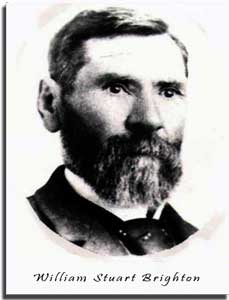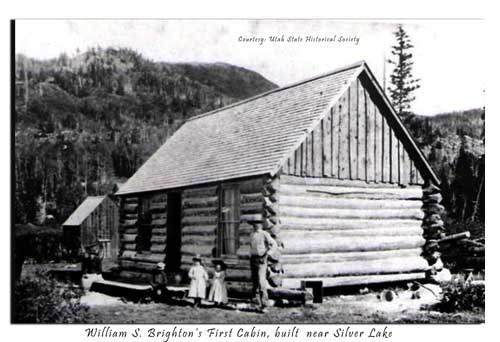I
Salt Lake City
Big Cottonwood Canyon
and
William Stuart Brighton
Settling Salt Lake
"This is the Place"
Those were the words that marked the end of the trail and a long journey for the first company of Mormon pioneers seeking a new land free of persecution and religious prejudice. That company was headed by Mormon leader Brigham Young and they arrived in the Great Salt Lake Valley on July 24th 1847.
"On our arrival we could behold nothing but one vast waste, scarcely a tree or shrub to be seen," wrote Levi Jackman, a member of this first company to arrive.
Great Salt Lake Valley 1847It was a harsh land with little vegetation and hard, sun-baked soil. The initial settlement was near the mouth of City Creek Canyon where immediately, irrigation ditches were dug and the soil worked to begin growing crops. Initial dwellings were made of adobe due to the lack of timber in the valley.
It was immediately apparent that the mountains, surrounding the Great Salt Lake Valley on the east, were going to play an integral role in the survival of the early immigrants. The canyons harbored much needed timber and more importantly, water for irrigation, drinking and later, power generation.
By March of 1848 Archibald Gardner built the first effective sawmill choosing to locate it in Mill Creek Canyon near where Mill Creek crosses the present day Highland Drive. Other mills were soon built and began operation in various areas, one being where today's Liberty Park is located. As early as the fall of 1849, Big Cottonwood Canyon began seeing mild activity regarding the harvesting of timber. 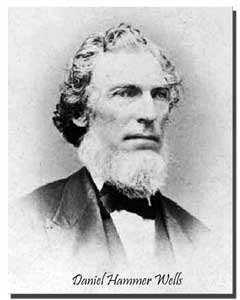 In 1852 the church hierarchy granted to Joseph Young (older brother of Brigham Young) "exclusive control of the Kanyon known as Big Cottonwood Kanyon from its mouth to the summit of the mountain on the East together with its tributaries... to have and to hold and to control the same". It was then that milling in Big Cottonwood began being organized. Because of the decision to build the new Temple and the Seventies Hall of Science, considerable resources would have to be developed. Brigham Young initiated the formation of the Big Cottonwood Lumber Company. One of the chosen principals in the newly formed lumber company was Daniel Hamner Wells, a formidable figure in church history.It was on Wells' land in Illinois that the settlement of Nauvoo was formed to provide refuge for Mormons fleeing from Missouri. When Mormons came under attack there he joined their cause and eventually immigrated to Utah in 1848.
In 1852 the church hierarchy granted to Joseph Young (older brother of Brigham Young) "exclusive control of the Kanyon known as Big Cottonwood Kanyon from its mouth to the summit of the mountain on the East together with its tributaries... to have and to hold and to control the same". It was then that milling in Big Cottonwood began being organized. Because of the decision to build the new Temple and the Seventies Hall of Science, considerable resources would have to be developed. Brigham Young initiated the formation of the Big Cottonwood Lumber Company. One of the chosen principals in the newly formed lumber company was Daniel Hamner Wells, a formidable figure in church history.It was on Wells' land in Illinois that the settlement of Nauvoo was formed to provide refuge for Mormons fleeing from Missouri. When Mormons came under attack there he joined their cause and eventually immigrated to Utah in 1848. Wells served the church and the community in many ways and became an effective and prominent leader of the new settlement. During the 1850's Wells supervised the construction of several mills in Big Cottonwood Canyon stretching the length of the canyon from the Storm Mountain area to the head of the canyon just below what is now known as Brighton.Lumber mills built in Big Cottonwood Canyon were named A through F in the order they were built not from the bottom of the canyon to the top.
Wells served the church and the community in many ways and became an effective and prominent leader of the new settlement. During the 1850's Wells supervised the construction of several mills in Big Cottonwood Canyon stretching the length of the canyon from the Storm Mountain area to the head of the canyon just below what is now known as Brighton.Lumber mills built in Big Cottonwood Canyon were named A through F in the order they were built not from the bottom of the canyon to the top.
William Stuart Brighton
In 1855 William Stuart Brighton, his pregnant wife, Catherine, and daughters Janet (4) and Mary (2), left Scotland and sailed to New Orleans as Mormon
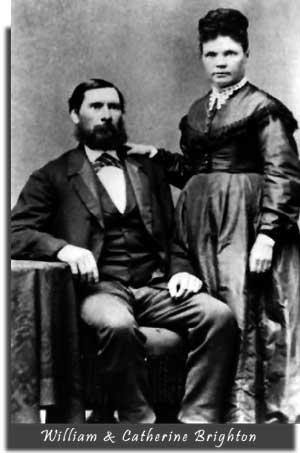 converts. On the journey Mary became ill, died and was buried at sea.From New Orleans they went to Missouri and after considerable struggles, replenishing of finances and the birth of their first son, Robert (June 1855), the Brighton family, in 1857, made the journey to the Great Salt Lake Valley with the Israel Evans Handcart Company, arriving on September 11th. (W.S. Brighton Journal).
converts. On the journey Mary became ill, died and was buried at sea.From New Orleans they went to Missouri and after considerable struggles, replenishing of finances and the birth of their first son, Robert (June 1855), the Brighton family, in 1857, made the journey to the Great Salt Lake Valley with the Israel Evans Handcart Company, arriving on September 11th. (W.S. Brighton Journal).
After their arrival in Salt Lake, Brighton worked at various jobs, one of them being for Daniel H. Wells, driving teams, harvesting and performing general labor. As a result of this early association with Wells, Brighton went to work helping to construct Mill F in 1864.Brighton's association with Wells must have been a very respectful and admiring one, as William's youngest son was named Daniel Hamner Wells Brighton. This was his first introduction to Big Cottonwood Canyon. Mill F was located near where the present day base facilities of the Solitude Ski Resort are located. Mill E, located just down canyon from present day Brighton, provided the lumber for the construction of Mill F, so it is likely that William was exposed to the top of the canyon and the Silver Lake Area.
This was his first introduction to Big Cottonwood Canyon. Mill F was located near where the present day base facilities of the Solitude Ski Resort are located. Mill E, located just down canyon from present day Brighton, provided the lumber for the construction of Mill F, so it is likely that William was exposed to the top of the canyon and the Silver Lake Area.
In the early 1870's Brighton again worked for Wells hauling lumber, and later became involved in mining in Big Cottonwood Canyon and recorded claims and built a small cabin in the Lake Catherine area. He also recorded claims near "Big Cottonwood Lake" (Silver Lake) and built a cabin there as well. It was the area surrounding this cabin that later evolved into the Brighton Hotel. Miners traveling from Park City to Alta would stop at the Brighton's to rest and word soon got out that Catherine was quite a cook. Brighton realized the potential of this site and in November of 1875, he applied for and received a patent on 80 acres surrounding the lake which was the West ½ of the NW ¼ of Section 35 Township 2 South Range 3 East, Salt Lake Meridian.The Document was recorded January 10th, 1876, Book 'K' of Mortgages, page 143.
Journal History, May 16, 1893 gives the following account: "A three-story structure to be erected at the resort at once. Mr. W. S. Brighton of this city has let contract to Taylor, Romney and Armstrong for erection of three-story frame rustic to be used as hotel at that popular little canyon retreat which bears his name and which is head of Big Cottonwood Canyon, near Silver Lake. The building will be 30 ft. by 100 ft. and will be modern throughout. Work will be rushed to finale. It is expected to be completed and ready by middle of June. Old hotel will be resumed for emergency. The contractor asked Mr. Brighton if he didn't think the hotel would look better with some dormers, and Brighton said that perhaps it would. With that they were put on; however, Mr. Brighton didn't realize it was going to cost him $2,000 more. The two floors of the hotel were used, but the upper floor was never furnished, being used as quarters for the help."
In order to accomplish the project, Brighton mortgaged the Brighton property and his home and property in Salt Lake.
His new facility was received well, but, unfortunately, on July 19 1894, during the first full year of operation, William's wife, Catherine, suffered a heart attack and died while serving lunch. Vowing to carry on, and soon after securing another mortgage for start-up operating expenses for the '95 season, the sixty-five year old innkeeper became ill from an infection in the joints of his hand and died on April 28, 1895. Major G.S. Erb managed the property during the '95 season.From a marketing brochure 'Beautiful Brighton, the Head of Big Cottonwood Canyon, Utah'. For the next two years his sons operated the hotel, but it did not do well and the contractors (Taylor, Romney and Armstrong) took possession in consideration of remaining, unpaid construction costs. Brighton's property in Salt Lake was sold, as well, to repay the mortgages.
For the next two years his sons operated the hotel, but it did not do well and the contractors (Taylor, Romney and Armstrong) took possession in consideration of remaining, unpaid construction costs. Brighton's property in Salt Lake was sold, as well, to repay the mortgages.
In May 1887 William's oldest son, 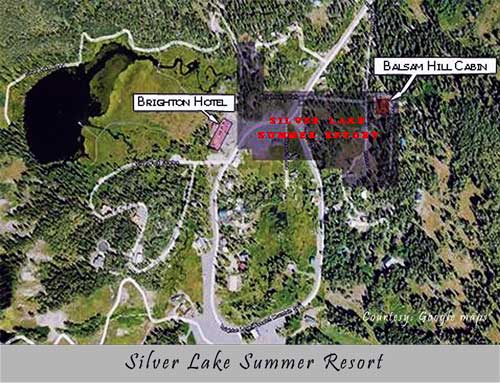 Robert A. Brighton, took advantage of the growing popularity of the area, applied for and was granted a patent on 80 acres adjacent to his father's. He soon subdivided a portion of this parcel, named it the "Silver Lake Summer Resort" and began selling lots. On July 26, 1897 lots 1, 2, 3, 46, 47 and 48 were sold to James H. and Leoline W. Brown. This was the eventual site of the Balsam Hill Cabin.
Robert A. Brighton, took advantage of the growing popularity of the area, applied for and was granted a patent on 80 acres adjacent to his father's. He soon subdivided a portion of this parcel, named it the "Silver Lake Summer Resort" and began selling lots. On July 26, 1897 lots 1, 2, 3, 46, 47 and 48 were sold to James H. and Leoline W. Brown. This was the eventual site of the Balsam Hill Cabin.
2 It was on Wells' land in Illinois that the settlement of Nauvoo was formed to provide refuge for Mormons fleeing from Missouri. When Mormons came under attack there he joined their cause and eventually immigrated to Utah in 1848.
3 Lumber mills built in Big Cottonwood Canyon were named A through F in the order they were built not from the bottom of the canyon to the top.
4 Brighton's association with Wells must have been a very respectful and admiring one, as William's youngest son was named Daniel Hamner Wells Brighton.
5 The Document was recorded January 10th, 1876, Book 'K' of Mortgages, page 143. To see the original title abstract: APPENDIX S
6 From a marketing brochure 'Beautiful Brighton, the Head of Big Cottonwood Canyon, Utah'.
